Eastern Bank, mutual with moxie
Crossing $10 billion line, Eastern advancing digitally while keeping the community in "community bank"
- |
- Written by Steve Cocheo
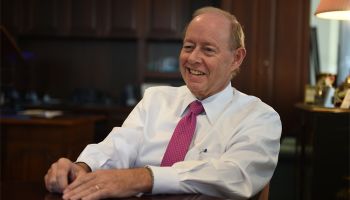 "I like time," says Richard Holbrook, Eastern chairman and CEO. "It goes one way—forward. ... You ask, 'How can I change the future?'"
"I like time," says Richard Holbrook, Eastern chairman and CEO. "It goes one way—forward. ... You ask, 'How can I change the future?'"
Richard Holbrook’s corner office and anteroom are chockablock with clocks. A pair of handsome, antique grandfather clocks, one with a moon-phase dial, catch your eye on the way in. A gamut of timekeeping sits on two tables and elsewhere in his office, right down to a pair of Dr Pepper clocks, one made from a soda can. At home, Holbrook has three windup mantle clocks with innards that he finds fascinating.
But there’s more to the collection than mechanical interest. It’s symbolic.
“I like time,” says Holbrook, chairman and CEO of $9.9 billion-assets Eastern Bank. “It goes one way—forward. You can look back, but you can’t do anything about the past, right? You can learn from the past, but you can’t change it. So you ask, ‘How can I change the future?’”
Eastern’s future has occupied Holbrook pretty much from the get-go. He joined the mutual bank 20 years ago as CFO. With year-end retirement in the offing, he can look back on growth from $1.8 billion when he arrived to Eastern’s impending advance over the $10 billion frontier.
To Holbrook, moving forward has always meant having ambitious goals. When he arrived, the bank, now headquartered in Boston, was concentrated in Essex County, to the city’s north.
“Our mission statement at the time said that we wanted to be the premier, independent commercial bank in northeastern Massachusetts,” explains Holbrook, “which meant Essex County. I asked, ‘Who has the number one market share in Essex?’ They told me, ‘We do.’ So I said, ‘You mean our goal is to be who we already are? Don’t we want to reach a little higher than that?’”
NO ONE-TIME BOOSTS
To Holbrook, who advanced to president in 2001 and to his present posts in 2007, simply growing larger didn’t mean as much as growing to a purpose. Creating a better Eastern, beyond just a bigger Eastern, was important.
“If you just buy another bank with cost-cutting in mind, that advantage goes away pretty fast,” says Holbrook. “There’s economy of scale because they don’t need a CEO, a CFO, a marketing manager anymore. But that’s just a one-time boost. It doesn’t build anything new.”
Elaborating, Holbrook explains that Eastern regards an acquisition as an opportunity to bring more to that bank than it offered to its customers before. “That’s products, service, delivery, and capability,” he says.
As one example, Holbrook cites Eastern’s 2008 deal for Massbank for Savings. The traditional home lender had $600 million in deposits, but much of this money sat in securities. “We liked the marketplace they had, and we knew we could do a lot more commercial lending than they had been doing,” says Holbrook. Eastern sold the investments, picking up liquidity that went into commercial and other lending, and meanwhile, it brought many new services to Massbank’s market.
Growth came both organically and through acquisitions, both of other mutual and commercial banks and of nearly two dozen insurance companies. But beyond that, there has been a willingness to allow the acquisition of other organizations to evolve the parent company. Often, beyond geographical reach, Eastern’s acquisitions have led to changes in business approach and loan mix, in its approach to its communities, in its specialties, in its corporate abilities, and, in 2003, in its relocation of its headquarters from Lynn, Mass., where its operations center remains, to Boston.
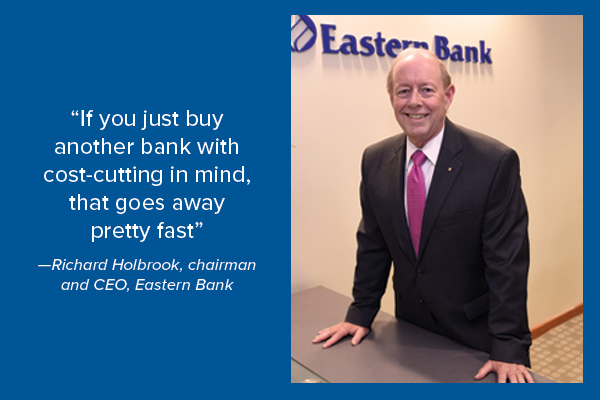
Acquiring people also comes into Eastern’s philosophy, most notably through bringing aboard fintech experts who became the core of Eastern Labs, a very large commitment to next-generation financial services. The Labs’ first new product release, Express Business Loan—an automated platform that can make working capital loans of up to $100,000 in under five minutes—won Eastern the distinction earlier this year as Celent’s “Model Bank of the Year.” And, as Eastern grew nearer to the $10 billion threshold that, among other things, entails direct examination by the Consumer Financial Protection Bureau, the bank brought aboard a regulatory veteran as head of compliance—CFPB’s former No. 2, Steve Antonakes.
In conversation, Holbrook makes it clear that Eastern still considers itself to be a community bank, and that mutuality, though a moderating influence on growth due to capital restrictions, remains part of its identity. Holbrook has enjoyed the freedom to pursue strategies without the need to appease stock markets and analysts.
“We found that we could be more than a single locality bank,” Holbrook points out. “We found we could be a bank for a larger region.”
How large is that region going to be?
“We actually figure that it’s the eastern part of the galaxy now—no limits,” Holbrook maintains.
JUST GET OVER IT
The words “no limits” may not resonate with many bankers who complain about the baggage that accompanies being an insured depository. Holbrook has participated actively in industry government relations efforts, including efforts to improve conditions for mutuals. But he declines to let regulatory mental malaise hinder Eastern.
“I’ve been hampered over the years by being short,” says Holbrook, who stands at five feet five. “So there are things I can’t get off certain shelves, you know? But when I get on an airplane, I fit the seat pretty well. Every model, whether you are a bank or a nonbank, has pluses and minuses. One group has more regulation; another has less. One has more access to capital; another less.”
As a mutual, Holbrook continues, he can’t sell stock, so acquisitions and other expansion are limited by Eastern’s earnings. “Is that a challenge? Sure, in the sense that I can’t grow as fast as somebody else might be able to grow,” he explains. “But I think we’ve grown at about the same pace that we’ve learned, so we have avoided mistakes that other banks who could grow really fast may not have avoided. And more banks have failed because they grew too fast than because they grew too slowly.”
Nonbank fintech players may not—at least for now—have bank-like regulation. But Holbrook says that many of those companies envy banks’ ability to raise low-cost deposits and access large, established customer bases—not to mention repositories of data that Eastern Labs digs into like a kid with a jar of jelly beans.
Holbrook says that the key is making the most of the pluses, and counteracting the minuses. “So I never sit there saying, ‘Oh, woe is me,’” says Holbrook. “Choose how to compete: Don’t complain about what you don’t have; take advantage of what you do.”
One exception, he adds with a grin: “Credit unions should pay taxes.”
Eastern Bank and Holbrook knew Steve Antonakes, senior vice-president and chief compliance officer, for years as Massachusetts Commissioner of Banks, before he went to CFPB. So he came aboard knowing Eastern pretty well. He sees his role in part as helping Eastern evolve into its new league.
“We’re moving into a period in which strategically Eastern has determined to take a little bit more risk than previously, through investments in innovation and steps along those lines,” maintains the former regulator. “These are sound strategic decisions, but still taking a little more risk than we have historically. And this is a bank that I think has generally not taken much risk. That’s coupled with operating in an environment of heightened regulatory oversight as a larger institution.”
Antonakes says his role thus far has been modernizing and maturing the Eastern compliance approach, including adoption of the “three lines of defense” concept, in which the front line takes on a much more significant role in compliance. In the future, he hopes the organization will begin to do more direct lobbying on financial issues that it finds important, to add its specific points to the industry’s shared perspectives.
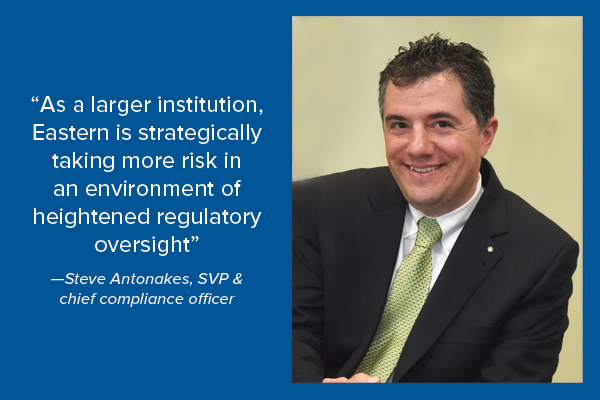 Click on box for a related article.
Click on box for a related article.
GETTING PAST LIMITS
Today, Eastern is America’s largest and, nearing 200, oldest mutual bank, and it is the largest independent bank in Massachusetts, but that is at this end of a long road.
In 1997, Eastern, venturing out of Essex County, opened a loan production office in Boston, during the tenure of Stanley Lukowski, Holbrook’s predecessor in his current post, who retired in 2006. The bank was in the midst of acquiring its first target outside of its “home zone” of Essex County—Hibernia Savings—but that wasn’t finalized until 1998. Management wanted to make it clear that it aspired to be a Boston-based company by planting that flag right away. Hibernia served markets south of Boston, but had several Boston locations. When the deal had been finalized, Lukowski moved his own office to the city’s downtown.
Holbrook said these moves—“Stan Lukowski was very wise in this”—had a two-fold purpose. First, to attract the kind of commercial bankers it wanted, and to demonstrate its intent to customers. The Boston presence declared that Eastern intended to be a serious business banking player.
“It was also a great first step to changing our own attitudes about ourselves,” says Holbrook.
“It definitely worked,” he adds. “We were able to attract people we wouldn’t have been able to get before. And once we had the right kind of business lenders, we were able to attract the kind of customers we needed to be able to expand.”
Today, through moves like these and other acquisitions, Eastern’s loan portfolio is heavily weighted toward C&I, CRE loans, and other commercial credit, at 63% of the portfolio at year-end 2015.
Over the years, most Eastern expansion has been via acquisitions—“with de novo branches, you wait forever” for the payoff, Holbrook explains. Where warranted, the bank continues to branch, though with a smaller branch size now.
MELD THE CULTURES
When banks buy nontraditional businesses, they tend to put them into silos, or otherwise segregate them so they don’t mix with the “banking culture.” That is something that Holbrook has learned to avoid, beginning with Eastern’s move into insurance.
“Too many banks that have gone into the insurance business decided to keep their banking and their insurance operations apart,” points out Holbrook. “‘Oh, they’re two different cultures; you can’t mix them.’”
Holbrook scoffs, “They miss all the opportunity. If you are going to do something together, then do it together.”
Eastern began with an outside partnership. This hit a bump when the partner needed more capital and decided to sell out. Eastern won a “vigorous bidding war with a couple of other banks” in 2002. Since then, it has been buying other agencies under that umbrella, now called Eastern Insurance Group. “We’ve done more of these than we have bank purchases,” Holbrook says, though most insurance acquisitions have been small. Eastern offers property, casualty, and life and health insurance plans to both firms and individuals.
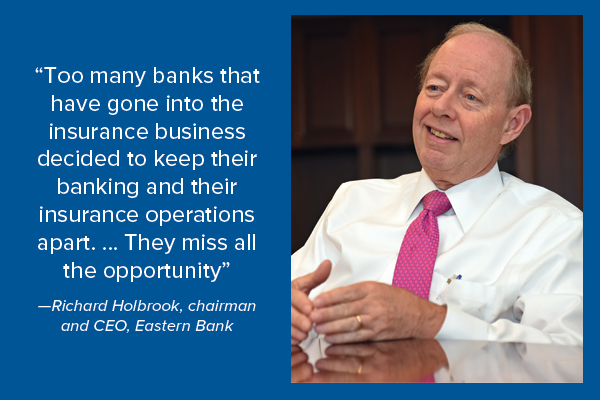
Collaborating, learning to share space, share customers lists, and find ways to market to each other’s customers were only the basics to Holbrook. He says that not putting insurance in a silo has benefited both the bank and its employees. Under insurance law, he says, a commercial lender can get $25 for referring a customer to the insurance arm. However, “if they get a license, they can get a big hunk of the commission.”
As a result, says Holbrook, bankers who took the next step were getting checks in the thousands for the first-year commissions, “just like a producer would in the insurance agency. All it took was for a couple of bankers to get those big checks, and suddenly everybody wanted to be licensed.”
Insurance is a significant part of the bank’s revenue. Approximately 350 employees work in the insurance group, which generated about $70 million in commissions for Eastern in 2015.
AT HOME WITH FINTECH
Speaking of culture, right on a wall at Eastern Bank headquarters, someone has hung a tie on a nail—the only tie in sight in the room. Nearby, in scrawled felt-tip marker, someone has tabulated the names of famous sci-fi robots right on the whiteboard wall. The same space includes work spaces that aren’t workstations. They are seats at long white tables—one long sprawl punctuated by very large Macintosh computer screens borne on articulated supports, and, on a corner, an inflatable ball chair instead of the usual swivel.
How would you feel about your staff writing on the walls? Could they, in turn, work without personal walls, except for a few small, glassed-in rooms shared for consultations? Could you cope with a completely open dress code?
Welcome to a portion of Eastern Labs, sitting just to the left of the bank’s headquarters lobby. It’s a work space doubling as a declaration.
Labs employees don’t look like “bankers”—they watch a visitor who does, dark suit and all, coming through, and you can hear them thinking, “Who’s the guy with the tie?” But it’s Labs that produced the award-winning Express Business Loan that management expects in time will change how it serves the small business market—and beyond.
“We put this smack dab in the middle of our operations,” says Holbrook. “You can’t miss them. They look different. Their work space looks different. They dress differently. We wanted them to come here and build cool stuff, buy cool stuff, and most importantly, change our culture. We can’t stay the same if we want to succeed in the future. And we have to figure out new ways to interact with our customers, new ways to service those customers, new ways for our employees to work, and to find new kinds of employees with new skill sets.”
Holbrook credits his announced successor, Robert Rivers, president and COO, for making this begin to happen. Several years ago, Rivers and some other Eastern bankers went to the nearby Cambridge Innovation Center—its website boasts, “More start-ups than anywhere else on the planet”—to meet innovators and see how the world was changing. This resulted in two things: the addition of Joseph Chung, a serial entrepreneur, to Eastern’s board, and engaging in a consulting deal with Dan O’Malley, who had previously run PerkStreet Financial, and a team working on financial innovation projects at the center.
The bankers found the experience eye opening. Weeks later, “Bob [Rivers] said, ‘I wonder if they’d join us? Because we could use them on the inside,’” says Holbrook. O’Malley, with key players, accepted and built a team that is now Eastern Labs. It works closely with, yet is distinct from, the bank’s IT department. O’Malley—a member of the Banking Exchange Editorial Advisory Board—is executive vice-president and chief digital officer.
The cultural impact of no ties and an open floor plan is of the surface. The more important philosophical, cultural shift that clearly emerges is a creative tension that O’Malley and the Labs bring to a banking environment.
O’Malley explains that a two-way exchange has taken place. The culture of the innovator hinges on a word bankers don’t like: Failure. Innovation begins with ideas, but what produces the ideas that light the lightbulb and grow is testing, failing, testing, failing, and revamping and retesting along the way.
“You’re going to fail if you’re doing your job right. In fact, you should fail more than half the time,” O’Malley explains. “The concept of failing and having ideas not work is a culturally challenging one within a bank.” O’Malley feels the bank has evolved so that it understands this Labs essential.
At the same time, he says that Labs staff has undergone its own evolution, even though some, like himself, have worked in financial organizations before.
“There’s a learning curve regarding how different technology needs to be when it’s built for banks versus built for a fintech company,” says O’Malley. “The rigor you have to hold yourself to for audit, for compliance, for regulatory work—it’s a higher standard.”
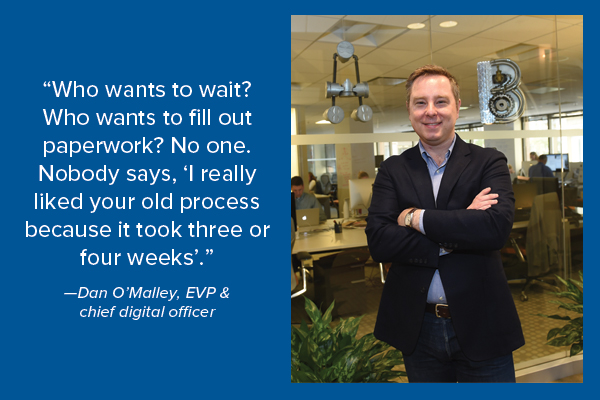 Click on box for a related article.
Click on box for a related article.
Meanwhile, says Holbrook, the IT operation in Lynn has been renovated for collaboration, and he believes the two tech teams have learned to work well together. “Our technology group was all for this,” he says. “They were waiting for senior management agreement. We needed to do something radical to make that happen.”
A major thrust for O’Malley’s group right now is a massive revamp of the bank’s entire digital face to the public. This involves look, feel, and ease of use. O’Malley says this goes far beyond millennials: “Who wants to wait? Who wants to fill out paperwork? No one. Nobody says ‘I really liked your old process because it took three or four weeks.’”
CROSSING THE RUBICON
Holbrook, it turns out, is not the kind of banker who never met a regulation he couldn’t dislike. “I’m actually not against regulation,” he says. “I wish regulation were much more by principle rather than by rules. But many rules exist because some players in the industries, banking as much as any, tried to find loopholes to get around things, and so they set up rules to stop that. It’s unfortunate.”
Holbrook sees the increasing regulatory regime that will come with moving beyond $10 billion in assets as mostly appropriate and even, in some aspects, positive. (The Durbin rule will cost Eastern $7 million or more, pre-tax, annually, and he’s not happy about that.)
One positive that he cites is the Dodd-Frank Act Stress Tests. Eastern has added staff to help beef up its existing stress test process to DFAST expectations. “Whether or not the DFAST test is perfect doesn’t really matter,” says Holbrook. “It’s a good idea that more complex organizations should have a better, more formalized process of understanding the risks that they’re taking, and how the risks interact with each other and with changes in the economy.”

All banks support their communities. At Eastern Bank that help takes some traditional and some atypical forms.
“As we’ve grown, we’ve added more expertise in certain areas, which has made us able to provide more solutions to our communities’ financial challenges,” says Richard Holbrook, chairman and CEO. “That will continue over time. We aren’t ever going to be JPMorgan Chase or Citicorp, working with the largest companies in the world. We’re going to be a local player who helps local businesses and local individuals succeed.”
Since 1999, Eastern has tithed for its communities, putting 10% of net income into its charitable foundation. Holbrook says that foundation, now $100 million in size, contributes $7 million to community causes annually.
“As a mutual, we have no shareholders, so this is our sort of dividend,” Holbrook explains. He says this helps sell Eastern to new markets and to potential acquisition candidates.
Acquiring Wainwright Bank & Trust in 2011 helped Eastern with its communities as Wainwright had community development lending expertise and strong ties to nonprofit organizations.
Beyond this, “Wainwright was very active in social justice issues,” says Holbrook. The bank took public positions, with rhetoric and sometimes with funding or credit, on many issues that some bankers would not feel comfortable commenting on. Eastern adopted this philosophy. “They had been longtime supporters of the LGBT community particularly, and they were one of the first organizations in this area to lend for housing for people with AIDS,” he says. “We’d always been supportive of many of these issues, but they were advocates, and Wainwright showed us how we could use our voice to be more than simply a supporter.”
“We were the first company in the country to sign onto a brief being filed challenging the constitutionality of the Defense of Marriage Act. We have since learned to use our advocacy voice in issues of gender equality, wage equality, and other areas,” says Holbrook.
Holbrook acknowledges that not all employees nor 100% of the board support the bank’s official stances. “We don’t take a stance on everything,” he says. “But we’re learning how to say what we believe is important for the rights of our customers and employees and communities. We’ll take a chance that we’ll lose a customer here or there who doesn’t agree with us. We’ll get a lot more. We’re not trying to get anybody angry at us—that’s not the point. We believe it is important to have an image that is consistent, that people understand, and that attracts a lot of people.”
Is Eastern sending a message of tolerance? “No, I would say the word is ‘respect,’” says Holbrook. Immigration rights is an area that he sees as important, as Boston is a city of immigrants. “Boston is a majority-minority community, meaning that more than 50% of the people who live here are nonwhite. Many are non-English speaking. A bank like ours can’t operate like it had all English-speaking, white people as their customer base because we don’t. How will we meet their needs? One way is to support their causes.”
Many bankers wouldn’t feel comfortable endorsing causes beyond those of the industry or general community. “We’re either courageous or foolhardy,” says Holbrook. “Depends on your view.”
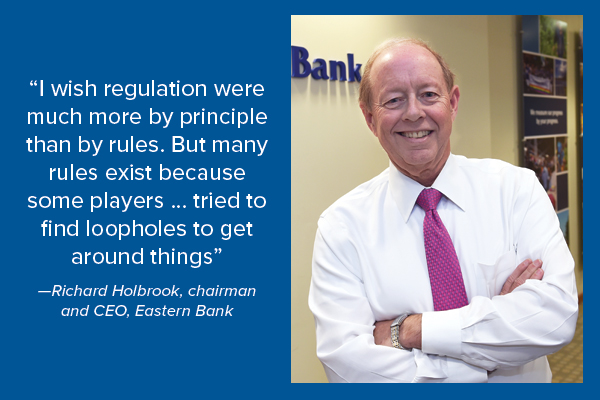
Tagged under CSuite, Community Banking,
Related items
- Wall Street Looks at Big Bank Earnings, but Regional Banks Tell the Story
- One in Five Oppose Fed’s Proposed Changes to Regulation II
- NYCB Receives $1 Billion Lifeline
- Tackling the Affordability Challenge with a Data-Driven Approach
- Fed Must Withdraw Amendments to Regulation II, Says ABA-led Alliance













